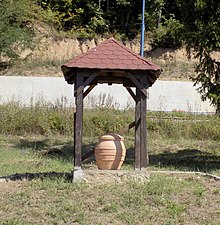
Maya ceramics are ceramics produced in the Pre-Columbian Maya culture of Mesoamerica. The vessels used different colors, sizes, and had varied purposes. Vessels for the elite could be painted with very detailed scenes, while utilitarian vessels were undecorated or much simpler. Elite pottery, usually in the form of straight-sided beakers called "vases", used for drinking, was placed in burials, giving a number of survivals in good condition. Individual examples include the Princeton Vase and the Fenton Vase.

Zlatibor is a mountainous region situated in the western part of Serbia.

Maria Poveka Montoya Martinez was a Native American artist who created internationally known pottery. Martinez, her husband Julian, and other family members, including her son Popovi Da, examined traditional Pueblo pottery styles and techniques to create pieces which reflect the Pueblo people's legacy of fine artwork and crafts. The works of Maria Martinez, and especially her black ware pottery, survive in many museums, including the Smithsonian, the Metropolitan Museum of Art, the Denver Art Museum, and more. The Penn Museum in Philadelphia holds eight vessels – three plates and five jars – signed either "Marie" or "Marie & Julian".

Mokra Gora is a village located in the city of Užice, southwestern Serbia. It is situated on the northern slopes of the Zlatibor Mountains. Emphasis on historical reconstruction has made it into a popular tourist center with unique attractions.

Požega, formerly Užička Požega, is a town and municipality located in the Zlatibor District of western Serbia. The population of the town is 12,362, while the municipality has 25,988 inhabitants. The town also has a non-profit organization, called Forca Požega.
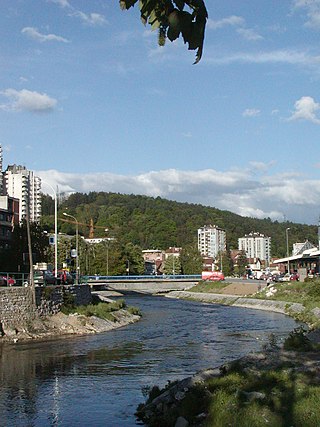
Đetinja is a river in western Serbia, a 75 km (47 mi) long natural but shorter headstream of the Zapadna Morava River.
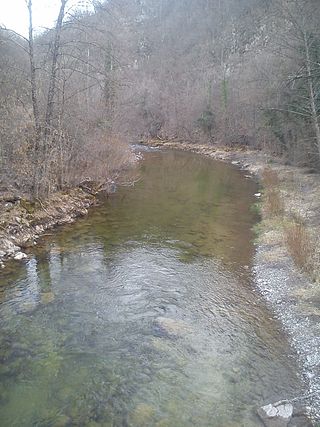
The Rzav is a river in southwestern Serbia. The 62 km long left tributary to the Golijska Moravica river, it originates from two headstreams, the Veliki Rzav and the Mali Rzav. The river is sometimes referred to as the Golijski Rzav to distinguish it from another Rzav river in Serbia, the Rzav of Zlatibor.

Lucy Martin Lewis was a Native American potter from Acoma Pueblo, New Mexico. She is known for her black-on-white decorative ceramics made using traditional techniques.

Sevojno is a town in western Serbia, a suburb of Užice. Administratively, it is one of two city municipalities which constitute the City of Užice. As of 2011, the town has 7,101 inhabitants.
Juanita Suazo Dubray also known as Juanita DuBray, is a Native American potter from Taos Pueblo, New Mexico. She is a lifelong resident of Taos Pueblo and descends from an unbroken line of Taos Pueblo natives. Her mother Tonita made traditional micaceous pottery for utilitarian use. She became interested in the micaceous pottery tradition in 1980 after a career of working as a pharmaceutical technician.

Gurney Slade quarry, grid reference ST626497 is a limestone quarry near Gurney Slade between Binegar and Holcombe, on the Mendip Hills, Somerset, England.
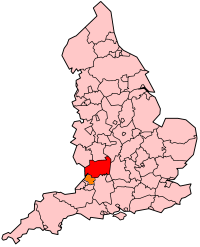
Gloucestershire is one of the most geologically and scenically diverse counties in England, with rocks from the Precambrian through to the Jurassic represented. These varying rock-types are responsible for the three major areas of the county, each with its own distinctive scenery and land-use - the Forest of Dean in the west, bordering Wales, the Cotswolds in the east, and in between, the Severn Vale.
The Užice dialect or Zlatibor dialect is a subdialect of the Shtokavian dialect of the Serbo-Croatian language. It is part of the Eastern Herzegovinian subdialects. It is traditionally spoken by c. 500,000 people – the Bosniaks and Serbs of the region – in the Zlatibor and Moravica Districts in the Užice region in the southwestern part of Serbia.

The Michigan Limestone and Chemical Company operated the world's largest limestone quarry, which is located near Rogers City in Presque Isle County, Michigan. It was formed and organized in 1910; however, production did not begin until 1912. Ownership of the quarry has changed a number of times, but it is still one of the largest producers of limestone in the United States. The quarry was inextricably interlinked with lake shipping and railroad transportation.

Mata Ortiz pottery is a recreation of the Mogollon pottery found in and around the archeological site of Casas Grandes (Paquimé) in the Mexican state of Chihuahua. Named after the modern town of Mata Ortiz, which is near the archeological site, the style was propagated by Juan Quezada Celado. Quezada learned on his own to recreate this ancient pottery and then went on to update it. By the mid 1970s, Quezada was selling his pottery and teaching family and friends to make it and the pottery was able to penetrate the U.S. markets thanks to efforts by Spencer MacCallum and later Walt Parks along with Mexican traders. By the 1990s, the pottery was being shown in museums and other cultural institutions and sold in fine galleries. The success of the pottery, which is sold for its aesthetic rather than its utilitarian value, has brought the town of Mata Ortiz out of poverty, with most of its population earning income from the industry, directly or indirectly.
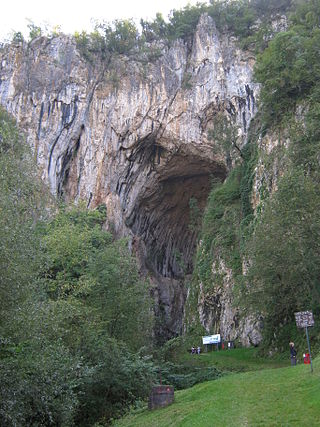
Drežnička Gradina is a mountain in western Serbia, located between cities of Požega and Užice. Its highest peak, Gradina, has an elevation of 932 m (3,058 ft) above sea level. On the cone-shaped hilltop, there is a small stone-built pyramid erected as monument to Yugoslav Partisans died in a battle against German forces in August 1941, at the time of the Republic of Užice.

Ham Green Pottery was produced between 1100 AD to 1250 AD at a hamlet above the village of Pill called Ham Green in the English county of Somerset.

Ancient Egyptian pottery includes all objects of fired clay from ancient Egypt. First and foremost, ceramics served as household wares for the storage, preparation, transport, and consumption of food, drink, and raw materials. Such items include beer and wine mugs and water jugs, but also bread moulds, fire pits, lamps, and stands for holding round vessels, which were all commonly used in the Egyptian household. Other types of pottery served ritual purposes. Ceramics are often found as grave goods.

Cord-marked pottery or Cordmarked pottery is an early form of a simple earthenware pottery. It allowed food to be stored and cooked over fire. Cord-marked pottery varied slightly around the world, depending upon the clay and raw materials that were available. It generally coincided with cultures moving to an agrarian and more settled lifestyle, like that of the Woodland period, as compared to a strictly hunter-gatherer lifestyle.

Pottery of Sri Lanka is one of the traditional small industries. The pottery industry is distributed almost throughout the country and it has a long history and a tradition.
